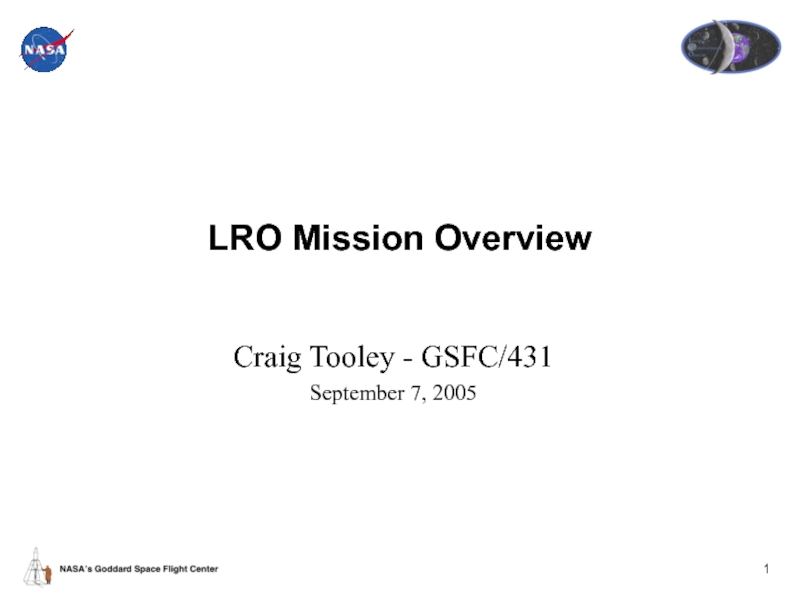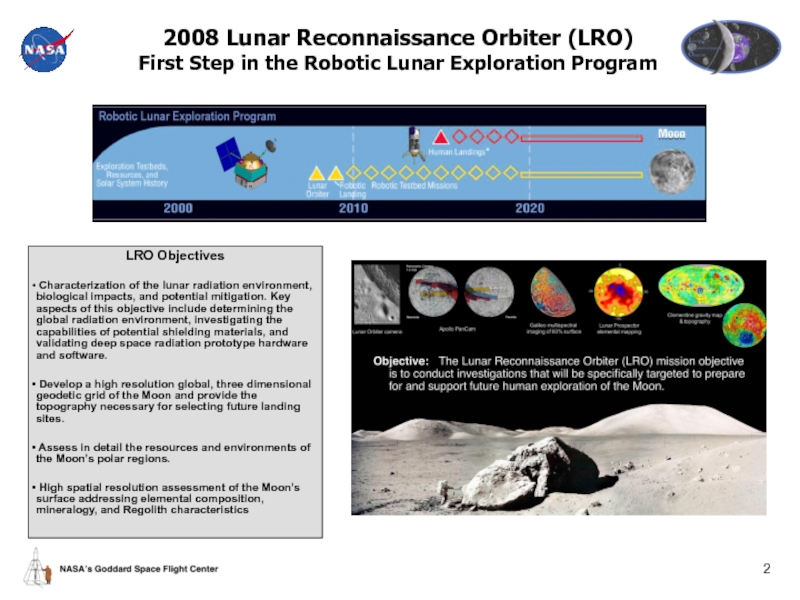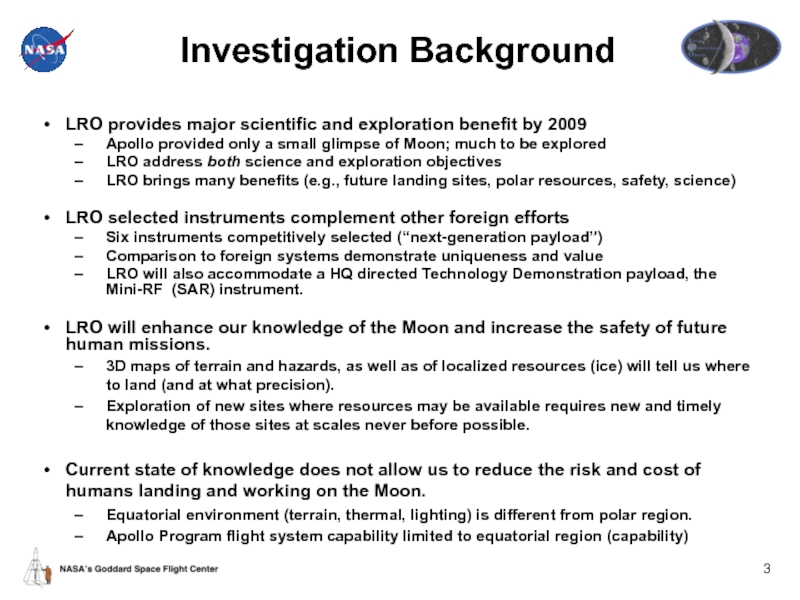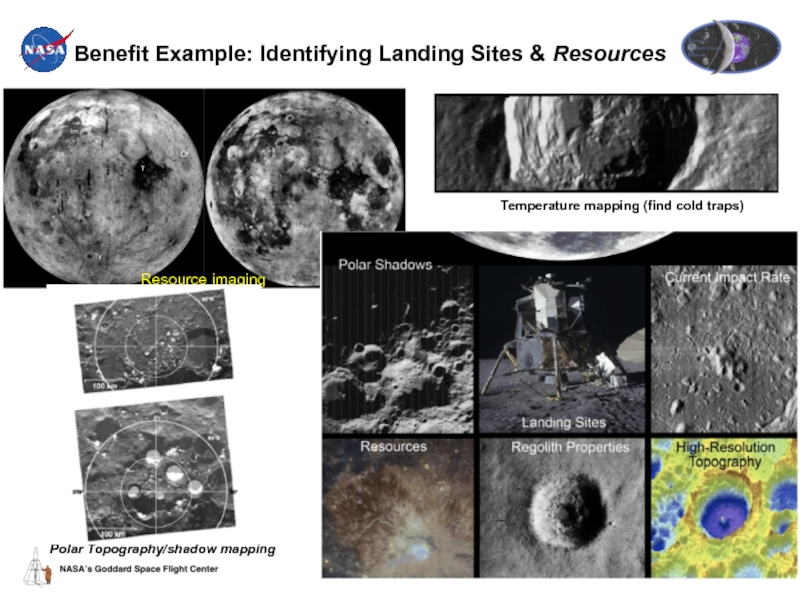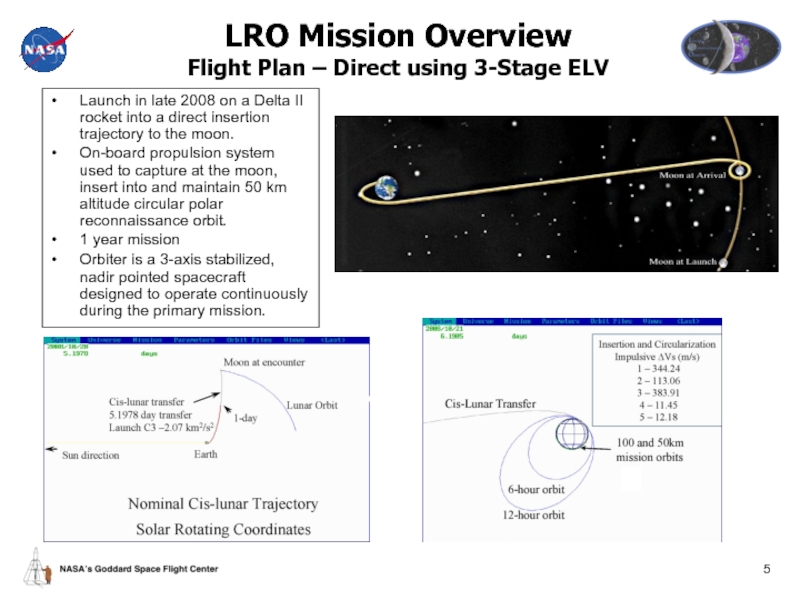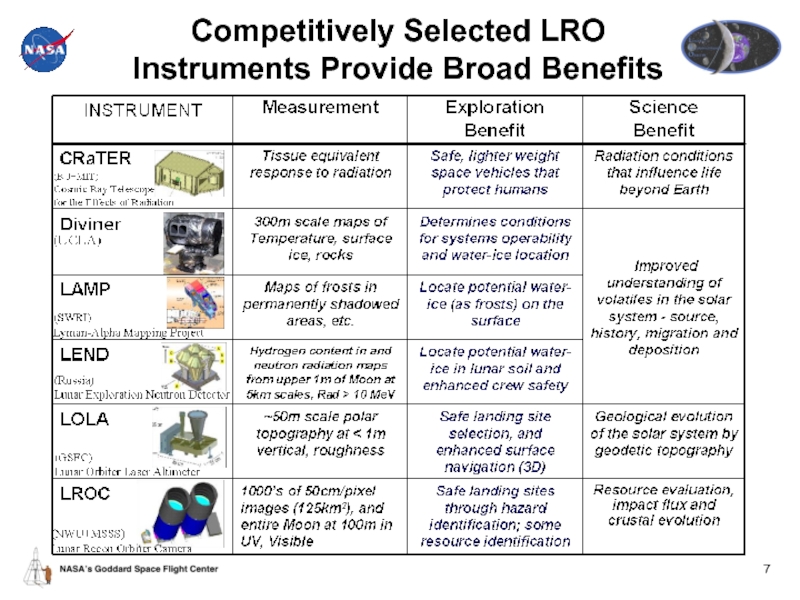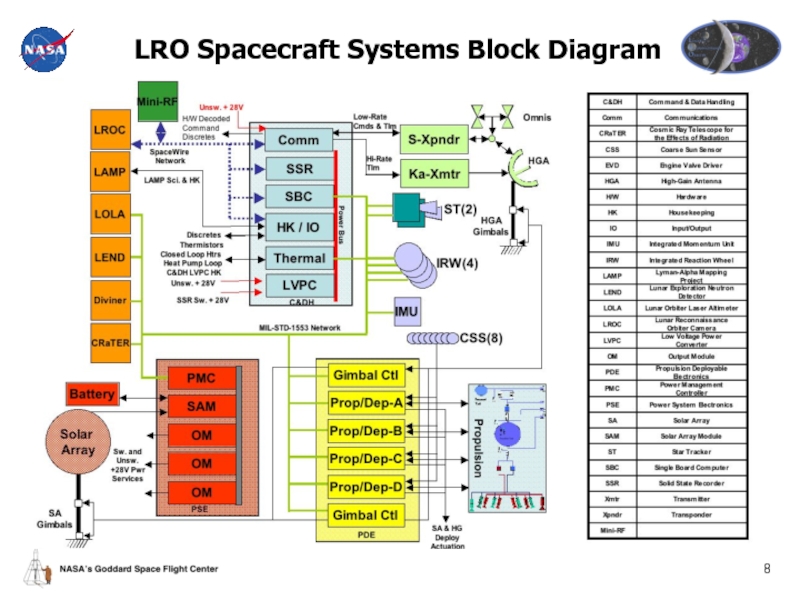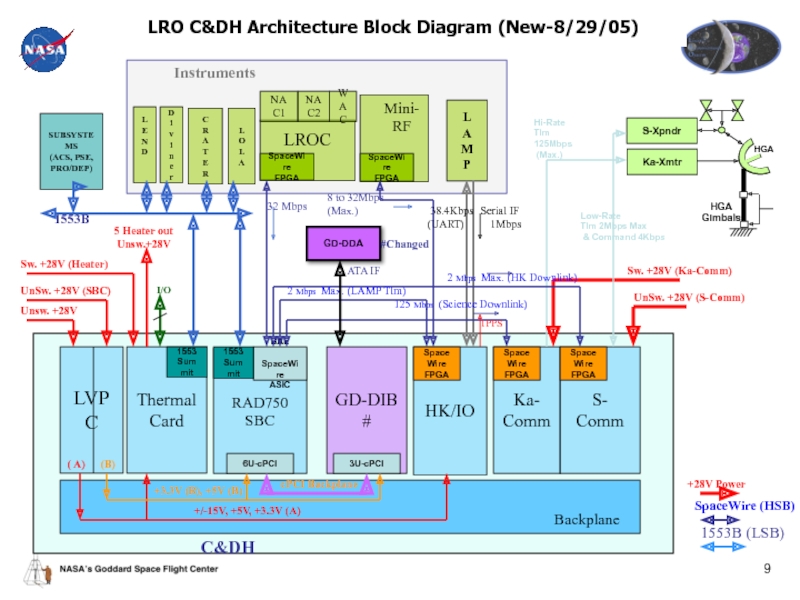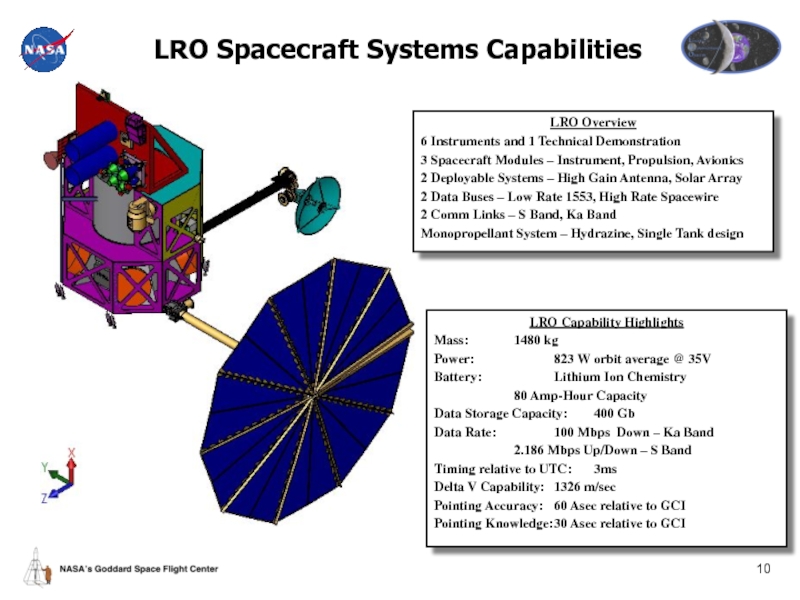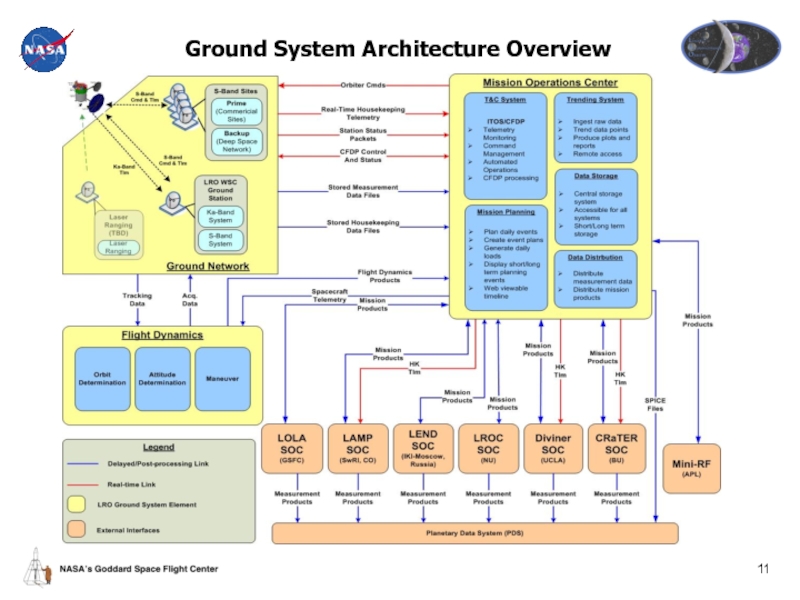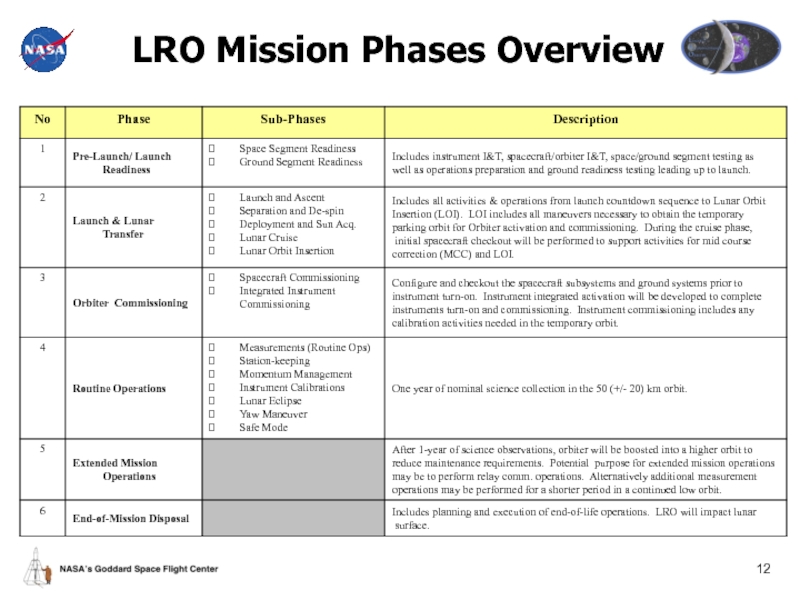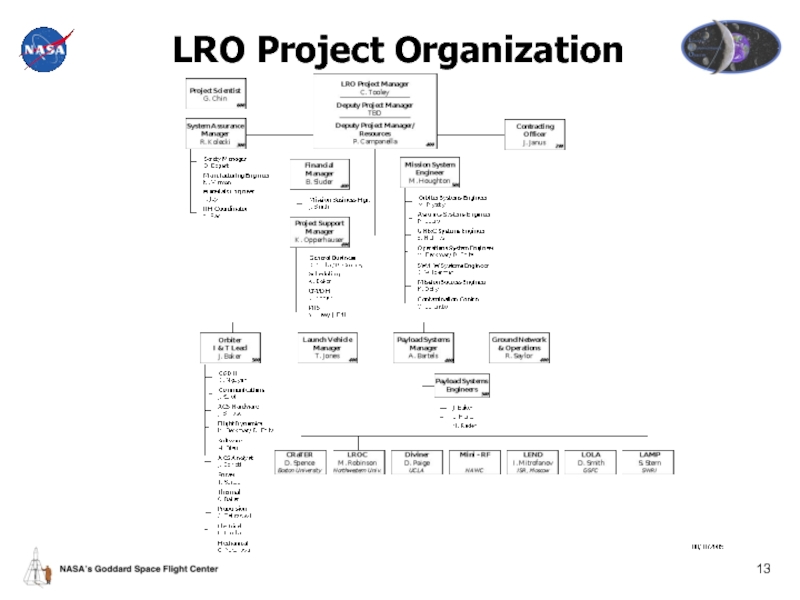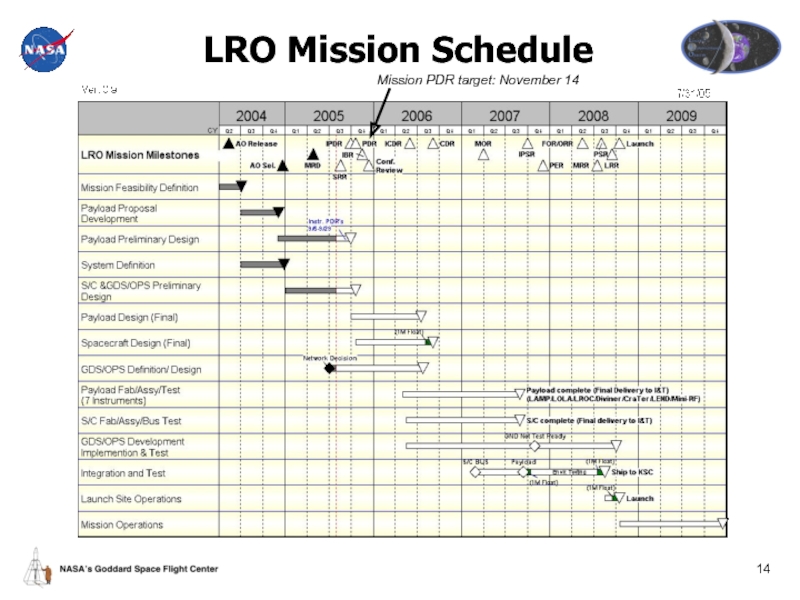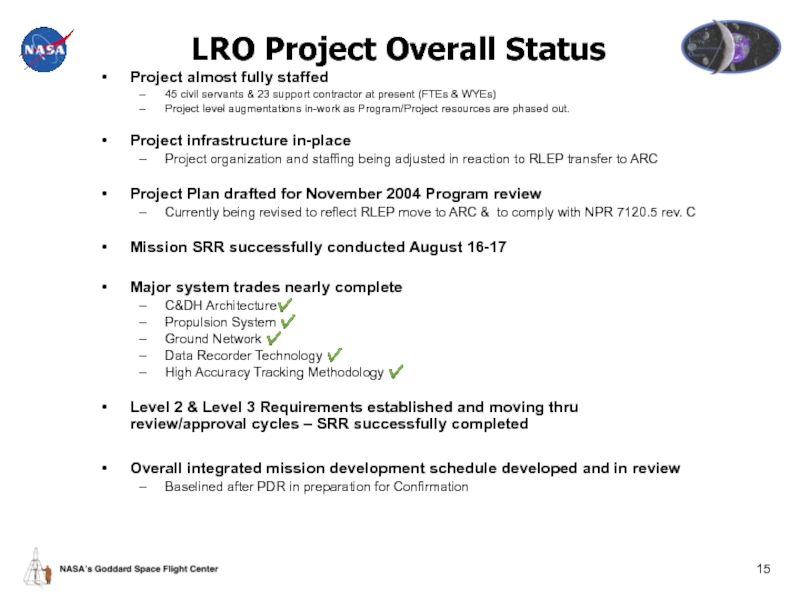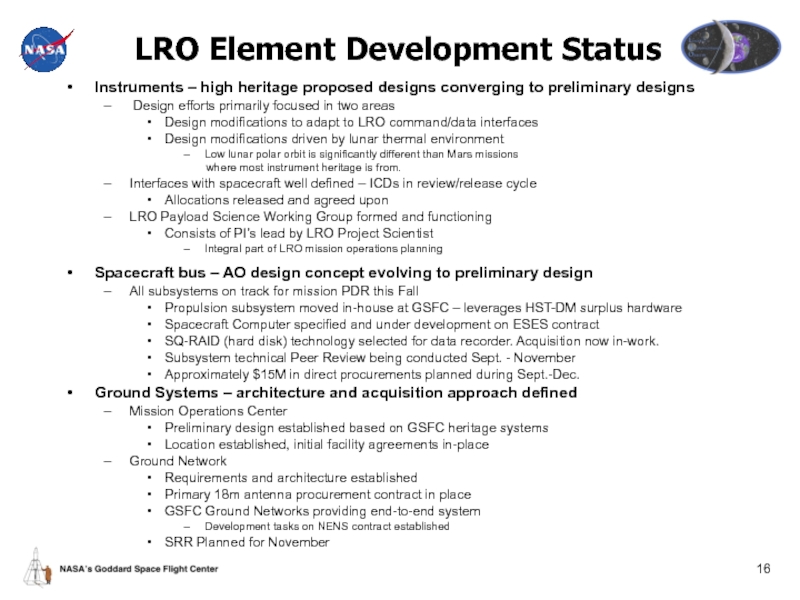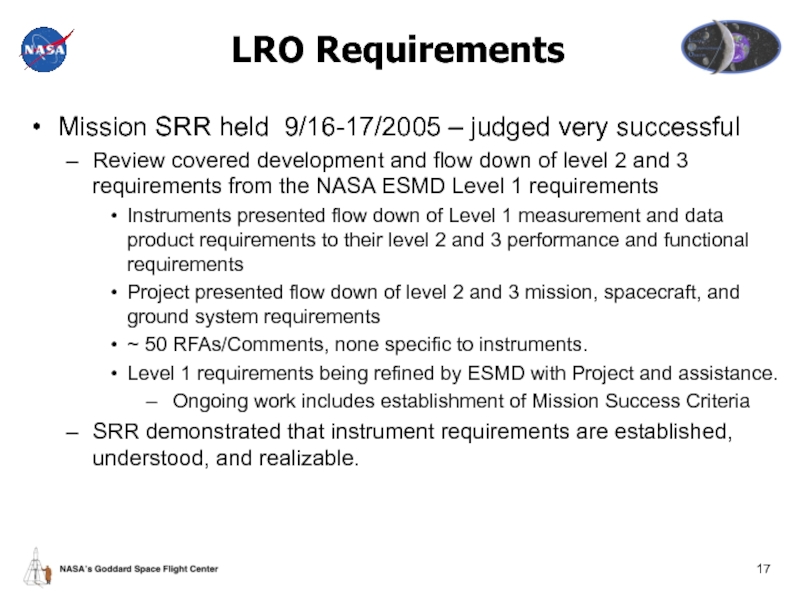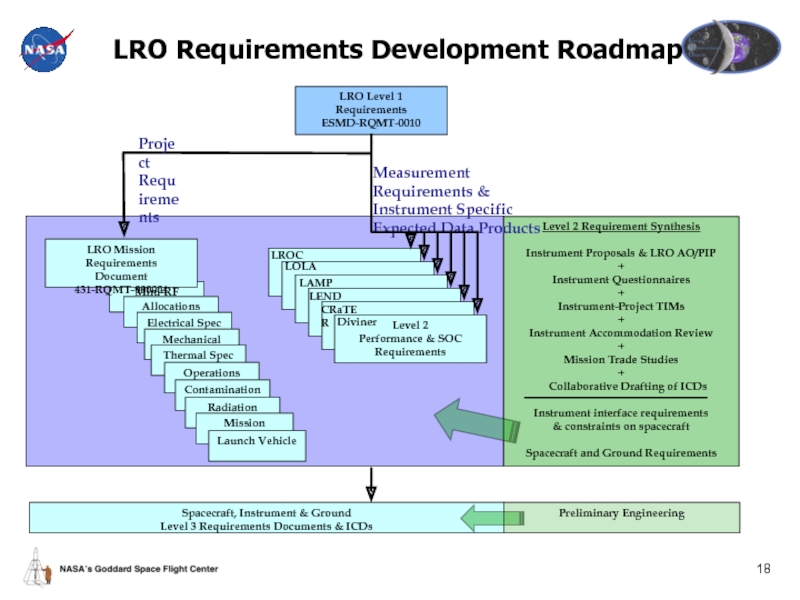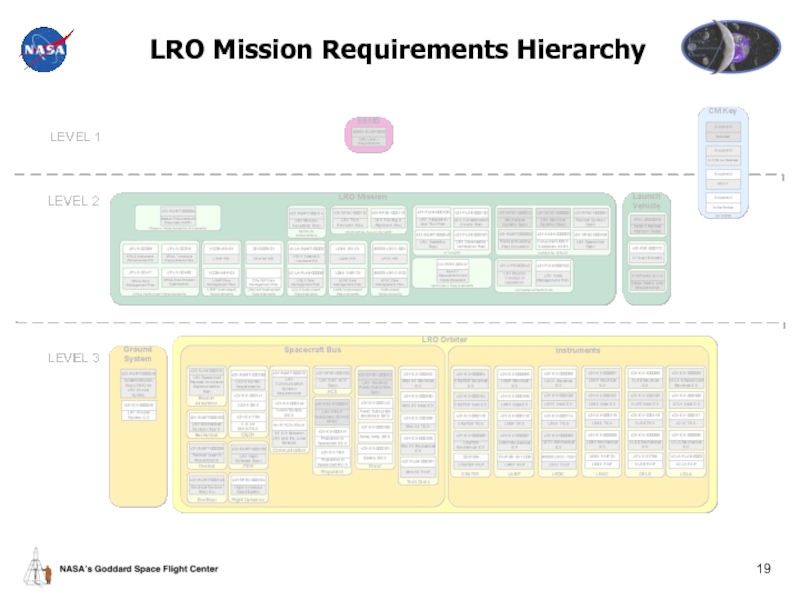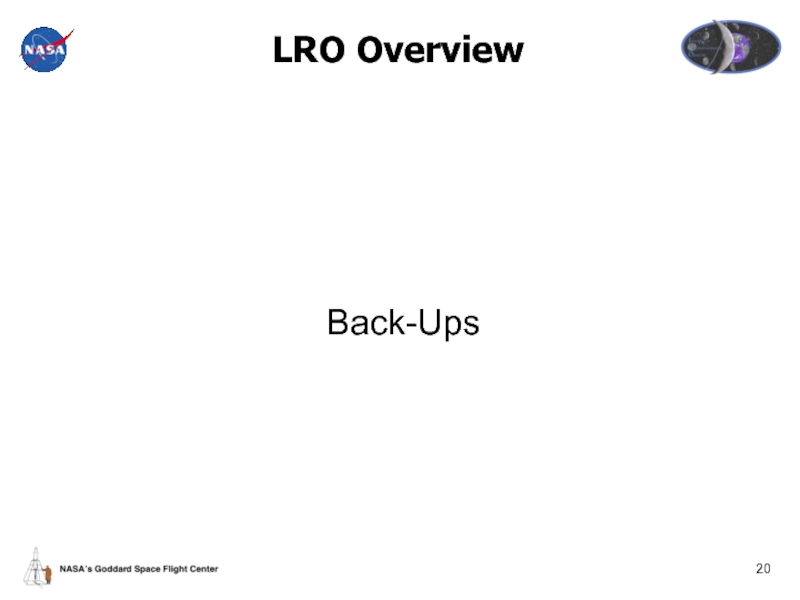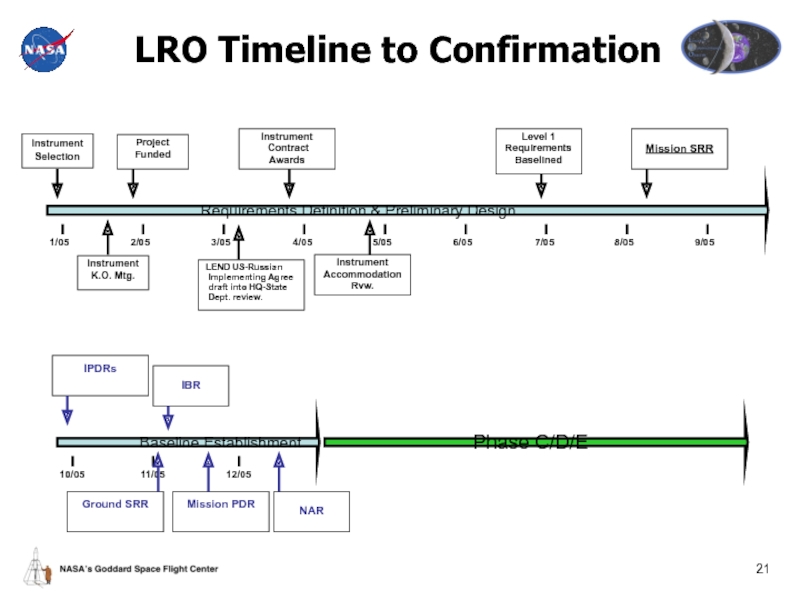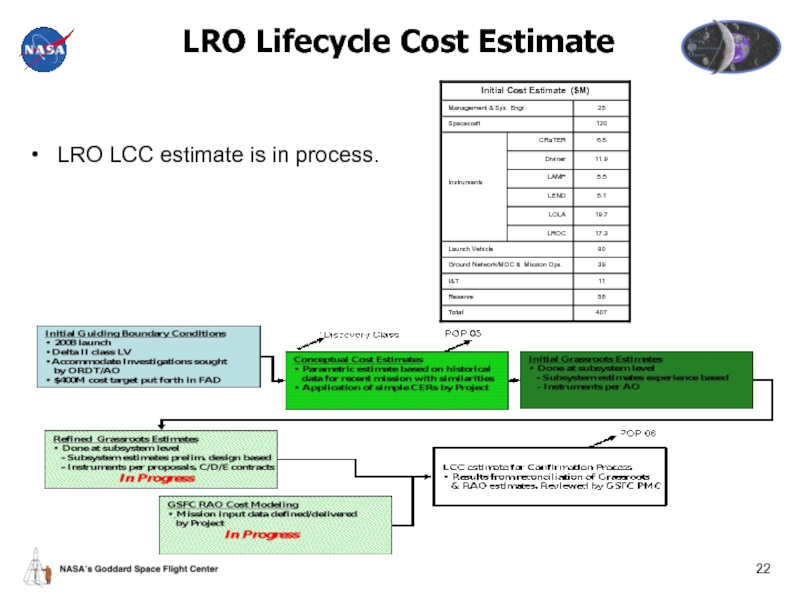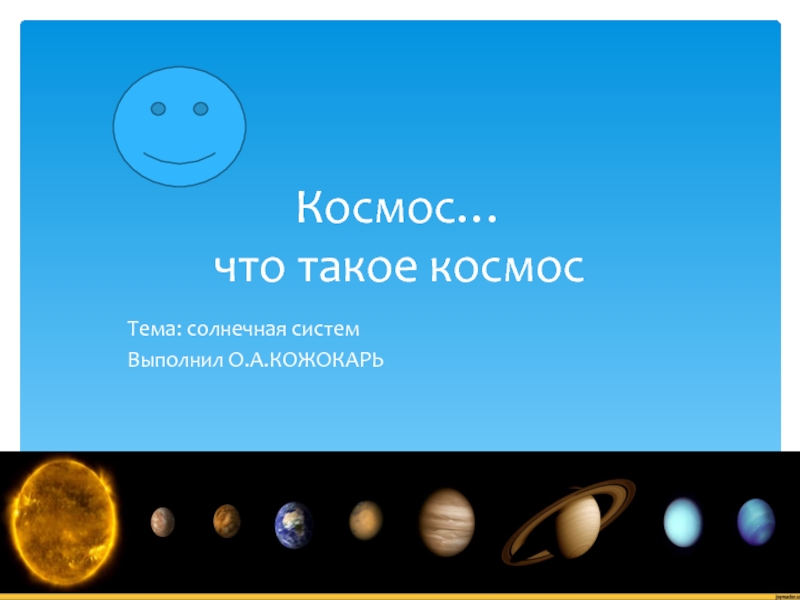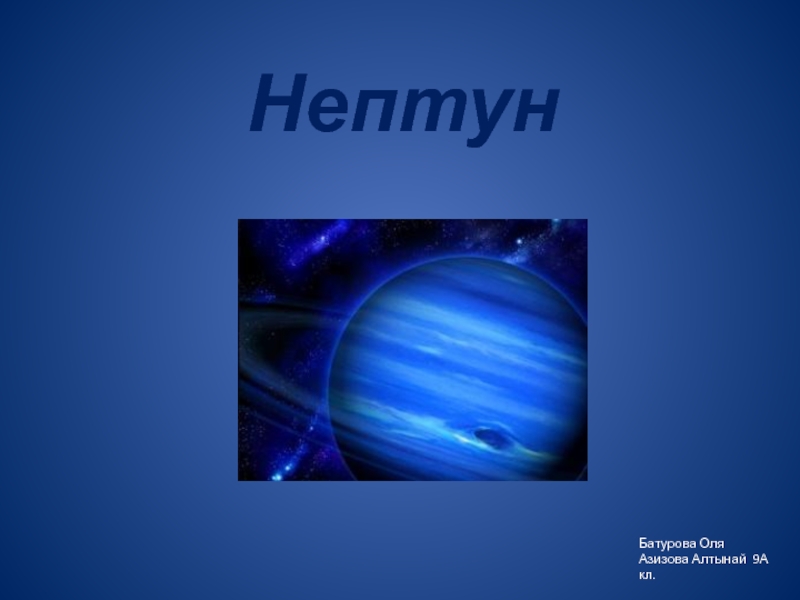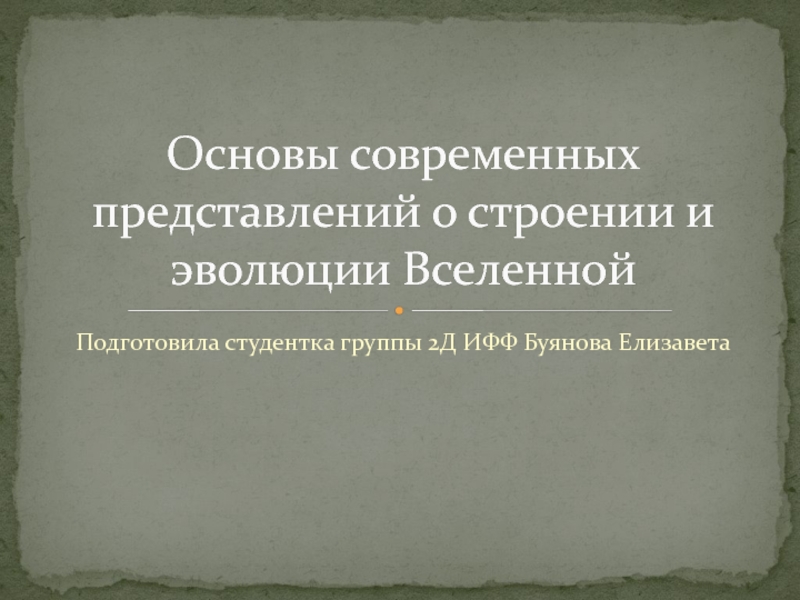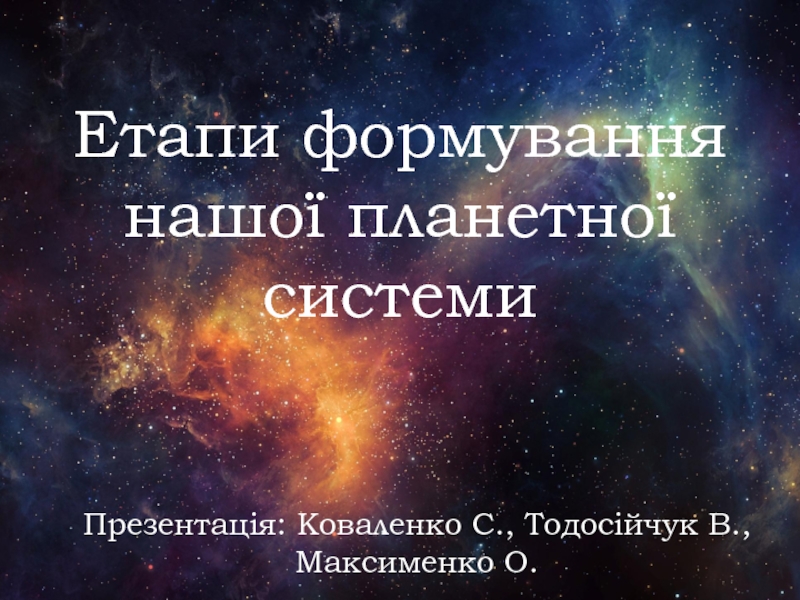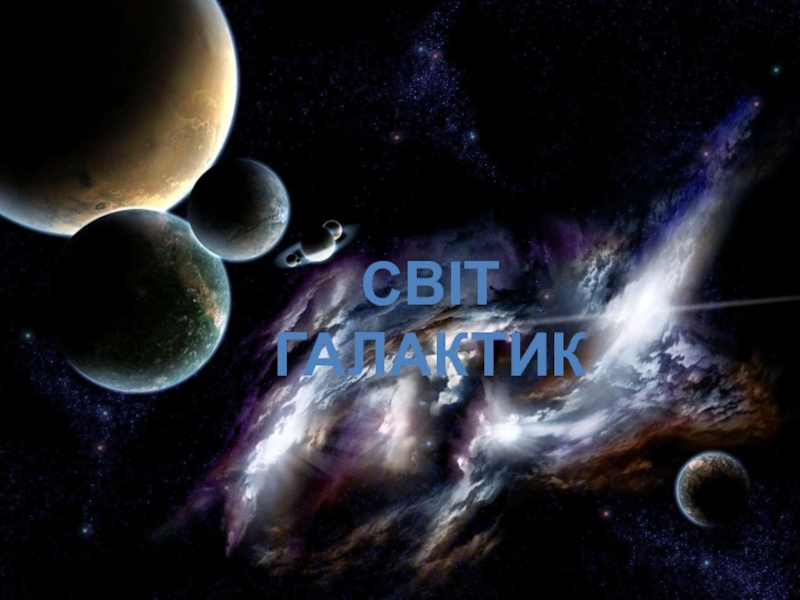- Главная
- Разное
- Дизайн
- Бизнес и предпринимательство
- Аналитика
- Образование
- Развлечения
- Красота и здоровье
- Финансы
- Государство
- Путешествия
- Спорт
- Недвижимость
- Армия
- Графика
- Культурология
- Еда и кулинария
- Лингвистика
- Английский язык
- Астрономия
- Алгебра
- Биология
- География
- Детские презентации
- Информатика
- История
- Литература
- Маркетинг
- Математика
- Медицина
- Менеджмент
- Музыка
- МХК
- Немецкий язык
- ОБЖ
- Обществознание
- Окружающий мир
- Педагогика
- Русский язык
- Технология
- Физика
- Философия
- Химия
- Шаблоны, картинки для презентаций
- Экология
- Экономика
- Юриспруденция
LRO Mission Overview презентация
Содержание
- 1. LRO Mission Overview
- 2. 2008 Lunar Reconnaissance Orbiter (LRO) First Step
- 3. LRO provides major scientific and exploration benefit
- 4. Benefit Example: Identifying Landing Sites & Resources
- 5. Launch in late 2008 on a Delta
- 6. LRO Mission Overview Orbiter
- 7. Competitively Selected LRO Instruments Provide Broad Benefits
- 8. LRO Spacecraft Systems Block Diagram
- 9. LRO C&DH Architecture Block Diagram
- 10. LRO Spacecraft Systems Capabilities LRO Capability Highlights
- 11. Ground System Architecture Overview
- 12. LRO Mission Phases Overview
- 13. LRO Project Organization
- 14. LRO Mission Schedule Mission PDR target: November 14
- 15. LRO Project Overall Status Project almost
- 16. LRO Element Development Status Instruments –
- 17. LRO Requirements Mission SRR held 9/16-17/2005
- 18. LRO Requirements Development Roadmap LRO Level
- 19. LRO Mission Requirements Hierarchy
- 20. LRO Overview Back-Ups
- 21. LRO Timeline to Confirmation Instrument Selection
- 22. LRO Lifecycle Cost Estimate LRO LCC estimate is in process.
Слайд 22008 Lunar Reconnaissance Orbiter (LRO) First Step in the Robotic Lunar Exploration
LRO Objectives
Characterization of the lunar radiation environment, biological impacts, and potential mitigation. Key aspects of this objective include determining the global radiation environment, investigating the capabilities of potential shielding materials, and validating deep space radiation prototype hardware and software.
Develop a high resolution global, three dimensional geodetic grid of the Moon and provide the topography necessary for selecting future landing sites.
Assess in detail the resources and environments of the Moon’s polar regions.
High spatial resolution assessment of the Moon’s surface addressing elemental composition, mineralogy, and Regolith characteristics
Слайд 3LRO provides major scientific and exploration benefit by 2009
Apollo provided only
LRO address both science and exploration objectives
LRO brings many benefits (e.g., future landing sites, polar resources, safety, science)
LRO selected instruments complement other foreign efforts
Six instruments competitively selected (“next-generation payload”)
Comparison to foreign systems demonstrate uniqueness and value
LRO will also accommodate a HQ directed Technology Demonstration payload, the Mini-RF (SAR) instrument.
LRO will enhance our knowledge of the Moon and increase the safety of future human missions.
3D maps of terrain and hazards, as well as of localized resources (ice) will tell us where to land (and at what precision).
Exploration of new sites where resources may be available requires new and timely knowledge of those sites at scales never before possible.
Current state of knowledge does not allow us to reduce the risk and cost of humans landing and working on the Moon.
Equatorial environment (terrain, thermal, lighting) is different from polar region.
Apollo Program flight system capability limited to equatorial region (capability)
Investigation Background
Слайд 4Benefit Example: Identifying Landing Sites & Resources
Polar Topography/shadow mapping
Resource imaging
Temperature mapping
Слайд 5Launch in late 2008 on a Delta II rocket into a
On-board propulsion system used to capture at the moon, insert into and maintain 50 km altitude circular polar reconnaissance orbit.
1 year mission
Orbiter is a 3-axis stabilized, nadir pointed spacecraft designed to operate continuously during the primary mission.
LRO Mission Overview
Flight Plan – Direct using 3-Stage ELV
Слайд 6LRO Mission Overview
Orbiter
Lunar Orbiter Laser Altimeter (LOLA) Measurement Investigation – LOLA will determine the global topography of the lunar surface at high resolution, measure landing site slopes and search for polar ices in shadowed regions.
Lunar Reconnaissance Orbiter Camera (LROC) – LROC will acquire targeted images of the lunar surface capable of resolving small-scale features that could be landing site hazards, as well as wide-angle images at multiple wavelengths of the lunar poles to document changing illumination conditions and potential resources.
Lunar Exploration Neutron Detector (LEND) – LEND will map the flux of neutrons from the lunar surface to search for evidence of water ice and provide measurements of the space radiation environment which can be useful for future human exploration.
Diviner Lunar Radiometer Experiment – Diviner will map the temperature of the entire lunar surface at 300 meter horizontal scales to identify cold-traps and potential ice deposits.
Lyman-Alpha Mapping Project (LAMP) – LAMP will observe the entire lunar surface in the far ultraviolet. LAMP will search for surface ices and frosts in the polar regions and provide images of permanently shadowed regions illuminated only by starlight.
Cosmic Ray Telescope for the Effects of Radiation (CRaTER) – CRaTER will investigate the effect of galactic cosmic rays on tissue-equivalent plastics as a constraint on models of biological response to background space radiation.
LRO Preliminary Design
Слайд 9
LRO C&DH Architecture Block Diagram (New-8/29/05)
RAD750
SBC
GD-DIB
#
HK/IO
Ka-
Comm
S-
Comm
LROC
L
A
M
P
L
O
L
A
NAC1
WAC
NAC2
32 Mbps
1Mbps
38.4Kbps
(UART)
Thermal
Card
1553B
Serial IF
L
E
N
D
D
i
v
i
n
e
r
C
R
A
T
E
R
SpaceWire (HSB)
1553B
125 Mbps (Science Downlink)
Mini-
RF
8 to 32Mbps
(Max.)
BAE
SpaceWire
ASIC
1553
Summit
3U-cPCI
SpaceWire
FPGA
SpaceWire
FPGA
SpaceWire
FPGA
SpaceWire
FPGA
SpaceWire
FPGA
C&DH
Instruments
LVPC
SUBSYSTEMS
(ACS, PSE,
PRO/DEP)
Unsw. +28V
Backplane
HGA
Hi-Rate
Tlm
125Mbps
(Max.)
S-Xpndr
Ka-Xmtr
HGA
Gimbals
Low-Rate
Tlm 2Mbps Max
& Command 4Kbps
UnSw. +28V (SBC)
1553
Summit
5 Heater out
Unsw.+28V
Sw. +28V (Ka-Comm)
UnSw. +28V (S-Comm)
+3.3V (B), +5V (B)
+/-15V, +5V, +3.3V (A)
I/O
( A)
(B)
Sw. +28V (Heater)
2 Mbps Max. (HK Downlink)
2 Mbps Max. (LAMP Tlm)
+28V Power
1PPS
6U-cPCI
GD-DDA
ATA IF
#Changed
cPCI Backplane
Слайд 10LRO Spacecraft Systems Capabilities
LRO Capability Highlights
Mass: 1480 kg
Power: 823 W orbit
Battery: Lithium Ion Chemistry
80 Amp-Hour Capacity
Data Storage Capacity: 400 Gb
Data Rate: 100 Mbps Down – Ka Band
2.186 Mbps Up/Down – S Band
Timing relative to UTC: 3ms
Delta V Capability: 1326 m/sec
Pointing Accuracy: 60 Asec relative to GCI
Pointing Knowledge: 30 Asec relative to GCI
LRO Overview
6 Instruments and 1 Technical Demonstration
3 Spacecraft Modules – Instrument, Propulsion, Avionics
2 Deployable Systems – High Gain Antenna, Solar Array
2 Data Buses – Low Rate 1553, High Rate Spacewire
2 Comm Links – S Band, Ka Band
Monopropellant System – Hydrazine, Single Tank design
Слайд 15LRO Project Overall Status
Project almost fully staffed
45 civil servants & 23
Project level augmentations in-work as Program/Project resources are phased out.
Project infrastructure in-place
Project organization and staffing being adjusted in reaction to RLEP transfer to ARC
Project Plan drafted for November 2004 Program review
Currently being revised to reflect RLEP move to ARC & to comply with NPR 7120.5 rev. C
Mission SRR successfully conducted August 16-17
Major system trades nearly complete
C&DH Architecture✔
Propulsion System ✔
Ground Network ✔
Data Recorder Technology ✔
High Accuracy Tracking Methodology ✔
Level 2 & Level 3 Requirements established and moving thru review/approval cycles – SRR successfully completed
Overall integrated mission development schedule developed and in review
Baselined after PDR in preparation for Confirmation
Слайд 16LRO Element Development Status
Instruments – high heritage proposed designs converging to
Design efforts primarily focused in two areas
Design modifications to adapt to LRO command/data interfaces
Design modifications driven by lunar thermal environment
Low lunar polar orbit is significantly different than Mars missions
where most instrument heritage is from.
Interfaces with spacecraft well defined – ICDs in review/release cycle
Allocations released and agreed upon
LRO Payload Science Working Group formed and functioning
Consists of PI’s lead by LRO Project Scientist
Integral part of LRO mission operations planning
Spacecraft bus – AO design concept evolving to preliminary design
All subsystems on track for mission PDR this Fall
Propulsion subsystem moved in-house at GSFC – leverages HST-DM surplus hardware
Spacecraft Computer specified and under development on ESES contract
SQ-RAID (hard disk) technology selected for data recorder. Acquisition now in-work.
Subsystem technical Peer Review being conducted Sept. - November
Approximately $15M in direct procurements planned during Sept.-Dec.
Ground Systems – architecture and acquisition approach defined
Mission Operations Center
Preliminary design established based on GSFC heritage systems
Location established, initial facility agreements in-place
Ground Network
Requirements and architecture established
Primary 18m antenna procurement contract in place
GSFC Ground Networks providing end-to-end system
Development tasks on NENS contract established
SRR Planned for November
Слайд 17LRO Requirements
Mission SRR held 9/16-17/2005 – judged very successful
Review covered
Instruments presented flow down of Level 1 measurement and data product requirements to their level 2 and 3 performance and functional requirements
Project presented flow down of level 2 and 3 mission, spacecraft, and ground system requirements
~ 50 RFAs/Comments, none specific to instruments.
Level 1 requirements being refined by ESMD with Project and assistance.
Ongoing work includes establishment of Mission Success Criteria
SRR demonstrated that instrument requirements are established, understood, and realizable.
Слайд 18
LRO Requirements Development Roadmap
LRO Level 1 Requirements
ESMD-RQMT-0010
Mini-RF
Allocations
Electrical Spec
Mechanical Spec
Thermal Spec
LRO Mission
Document
431-RQMT-000004
Level 2
Performance & SOC
Requirements
Level 2 Requirement Synthesis
Instrument Proposals & LRO AO/PIP
+
Instrument Questionnaires
+
Instrument-Project TIMs
+
Instrument Accommodation Review
+
Mission Trade Studies
+
Collaborative Drafting of ICDs
Instrument interface requirements
& constraints on spacecraft
Spacecraft and Ground Requirements
Operations
Contamination
Radiation
Mission Assurance
LOLA
LROC
LAMP
LEND
CRaTER
Diviner
Project Requirements
Measurement Requirements &
Instrument Specific Expected Data Products
Spacecraft, Instrument & Ground
Level 3 Requirements Documents & ICDs
Preliminary Engineering
Launch Vehicle
Слайд 21LRO Timeline to Confirmation
Instrument
Selection
Project
Funded
Instrument
K.O. Mtg.
1/05
2/05
3/05
4/05
5/05
7/05
6/05
8/05
9/05
Instrument
Accommodation
Rvw.
Instrument
Contract
Awards
Mission SRR
Requirements Definition &
Level 1
Requirements
Baselined
LEND US-Russian
Implementing Agree
draft into HQ-State
Dept. review.
10/05
11/05
12/05
IPDRs
Mission PDR
IBR
NAR
Baseline Establishment
Phase C/D/E
Ground SRR
